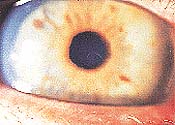New argon laser-based treatment tacks down poorly attached epithelial cells
Corneal resurfacing provides a safe and effective treatment for recurrent corneal erosion, surgeon says.
Click Here to Manage Email Alerts
Whether the result of trauma or corneal abnormality, recurrent corneal erosion is both painful and difficult to treat. I have developed a new and permanent treatment for this condition, called corneal resurfacing, that uses an argon laser to tack down poorly attached epithelial cells.
Recurrent corneal erosion
 ---Gerard M. Nolan,
MD
---Gerard M. Nolan,
MD
Patients with recurrent corneal erosion experience
repeated episodes of corneal pain, tearing, photophobia and foreign body
sensation. While these symptoms usually occur upon awakening, they can be
experienced at any time of day, and are due to the sloughing of epithelial
cells that are poorly attached to the deeper layers of the cornea.
Historically, patients with recurrent corneal erosion were often dismissed because minor epithelial defects are repaired so quickly that it can be difficult for a doctor to find signs of the abrasion, even just a few hours after the acute stage. Now it is known that in the days or years subsequent to certain kinds of abrading trauma — or as a result of an inherent abnormality — there is a reduction in the formation of protein junctions, called desmosomes, that attach the corneal basement membrane to Bowman’s layer. The result is that the loosely attached epithelial sheets are periodically sloughed off in the affected areas, exposing the nerve endings and causing the acute episodes of painful symptoms.
Corneal resurfacing: a new treatment
 ---A 58-year-old female with a 10-year history of
recurrent corneal erosion from corneal basement membrane pathology. The active
area was treated with four applications.
---A 58-year-old female with a 10-year history of
recurrent corneal erosion from corneal basement membrane pathology. The active
area was treated with four applications.
The first-line treatment
for recurrent corneal erosion is lubrication, either with ointments or
artificial tear drops. Patching and bandage contact lenses also have been used
successfully (although use of the bandage lenses has been associated with an
increased incidence of infectious keratitis). When these methods fail, a more
permanent solution requires improving the adherence between the epithelium and
the underlying layers of the cornea.
I have developed a permanent treatment for recurrent corneal erosion using an argon laser. Normally, low levels of laser light pass through the transparent cornea without affecting it. By applying a pigment very focally to the affected regions of the cornea, the laser energy can be converted into heat, solely at the pigmented areas. The laser causes a burn in the focally heated corneal regions, and the subsequent scarring creates firm adhesions between the epithelial cells and Bowman’s layer. The adjacent, unpigmented corneal tissue remains transparent to the laser light and is not affected by it. A typical laser treatment would be 0.1 to 0.2 seconds/spot at 150 mW to 400 mW, with the spots being 50 µm to 100 µm in diameter. In a sense, this method uses a laser “tack” to nail down epithelial cell “shingles.” The low levels of laser energy used in the treatment and the thermal mode of action do not lead to corneal tissue being removed, and the shape of the cornea is not altered.
I have treated 12 patients with recurrent corneal erosion using this technique. The patients’ corneas were infused with 1% tetracaine and patients were fitted with an eyelid speculum. The corneal surface was marked with pigment over the areas of defect, avoiding the central optical axis. An argon laser with a conventional slit lamp attachment was used for focal applications of laser light, and the entire procedure required only a few minutes per eye. The procedure was painless, and the epithelium had healed by the day after treatment. Any symptoms that were present preoperatively were relieved, and there was no postoperative tearing or foreign body sensation. The patients were followed for 8 to 42 months (with an average of 2 years), and no recurrence of symptoms was seen. Upon examination, the adhesions induced by the laser treatment were visible throughout the follow-up period.
Comparison with current treatments
 ---Higher
magnification seen at day 2 postop after corneal
resurfacing.
---Higher
magnification seen at day 2 postop after corneal
resurfacing.
A number of other surgical treatments have been
used to improve the adherence of the epithelium to the deeper corneal layers,
including superficial epithelial keratectomy and puncturing the anterior
corneal stroma with a needle. Although effective, superficial epithelial
keratectomy requires the scraping of a large surface, which is painful, can be
slow to heal, and carries a risk of infection. Besides the concern about
infection, puncturing the anterior cornea carries the risk of puncturing
through the cornea, and generates considerable patient apprehension.
The excimer laser also has been used to treat this condition. It is an expensive treatment option and, as with superficial epithelial keratectomy, treatment with the excimer laser exposes the nerves on the entire corneal surface, which is painful for the patient and can require several days to heal. In addition, the excimer laser ablates the treated tissue and can reshape the cornea, altering refraction.
In contrast, the corneal resurfacing technique described here provides a safe, painless, effective and permanent treatment for recurrent corneal erosion without ablating tissue or altering the shape of the cornea.
Moreover, the widespread availability of argon lasers means that patients can have ready access to this treatment at a reasonable cost.
For Your Information:
- Gerard Michael Nolan, MD, can be reached at Nolan Eye & Laser Center, 231 Farmington Ave., Farmington, CT 06032 U.S.A.; +(1) 860-674-9627; fax: +(1) 860-676-8622; e-mail: ktpeye@aol.com or Gnolanmd@aol.com. Dr. Nolan has no direct financial interest in the products mentioned in this article, nor is he a paid consultant for any companies mentioned.
